- News
- Reviews
- Bikes
- Accessories
- Accessories - misc
- Computer mounts
- Bags
- Bar ends
- Bike bags & cases
- Bottle cages
- Bottles
- Cameras
- Car racks
- Child seats
- Computers
- Glasses
- GPS units
- Helmets
- Lights - front
- Lights - rear
- Lights - sets
- Locks
- Mirrors
- Mudguards
- Racks
- Pumps & CO2 inflators
- Puncture kits
- Reflectives
- Smart watches
- Stands and racks
- Trailers
- Clothing
- Components
- Bar tape & grips
- Bottom brackets
- Brake & gear cables
- Brake & STI levers
- Brake pads & spares
- Brakes
- Cassettes & freewheels
- Chains
- Chainsets & chainrings
- Derailleurs - front
- Derailleurs - rear
- Forks
- Gear levers & shifters
- Groupsets
- Handlebars & extensions
- Headsets
- Hubs
- Inner tubes
- Pedals
- Quick releases & skewers
- Saddles
- Seatposts
- Stems
- Wheels
- Tyres
- Health, fitness and nutrition
- Tools and workshop
- Miscellaneous
- Buyers Guides
- Features
- Forum
- Recommends
- Podcast
£7,799.00
VERDICT:
Fast, smooth and fun, the new Synapse is an exceedingly good endurance bike
Weight:
7,220g
Contact:
At road.cc every product is thoroughly tested for as long as it takes to get a proper insight into how well it works. Our reviewers are experienced cyclists that we trust to be objective. While we strive to ensure that opinions expressed are backed up by facts, reviews are by their nature an informed opinion, not a definitive verdict. We don't intentionally try to break anything (except locks) but we do try to look for weak points in any design. The overall score is not just an average of the other scores: it reflects both a product's function and value – with value determined by how a product compares with items of similar spec, quality, and price.
What the road.cc scores meanGood scores are more common than bad, because fortunately good products are more common than bad.
- Exceptional
- Excellent
- Very Good
- Good
- Quite good
- Average
- Not so good
- Poor
- Bad
- Appalling
First published 20 December 2017
Compared with the previous version, the new Cannondale Synapse is smoother, more comfortable, lighter and stiffer – and one of the best endurance bikes on the market right now.
- Pros: Lighter, better handling, stiffer and more comfortable than the previous bike
- Cons: Expensive in this build, not class-leading bump absorption
The Synapse traces its roots back to 2006, introduced at a time when demand was growing for bikes that offered more comfort than the race bikes they were loosely based on. For 2018 the Synapse has been taken back to the drawing board – and the results are very impressive.
> Find your nearest dealer here
The new frame is not only lighter, helping to negate the disc brake weight penalty, it also has space for wider tyres and, recognising that it's a key bike for the UK market, mudguard eyelets.
Ride and handling
The Synapse has always offered lovely predictable handling together with impressive all-day comfort, but the new design is a noticeable improvement in every key aspect that defines how a bike performs. The changes that make it lighter, stiffer and more compliant help return the new Synapse to the front of the endurance bike pack.
The lighter frame certainly makes a noticeable difference to the overall weight; at 7.25kg (15.98lb) this 56cm bike is one of the lightest disc brake-equipped endurance bikes we've tested at road.cc, and it's knocking on the door of some race bikes. It's lighter, for example, than the Canyon Ultimate CF SLX Disc I tested back in March, though there are some spec differences that will account for some of that.
That helps it excel on the climbs, and on my local lumps and bumps the Synapse put in a stellar performance. Steep or gradual gradients, the Synapse makes great progress. And when you get out of the saddle to sprint the last 100 metres to the summit, the high level of stiffness from the fork through to the bottom bracket makes itself felt in how directly the bike responds, through the pedals and the handlebar.
On descents, boy is the Synapse an eager beaver. I had my first taste of the new Synapse's descending talents at the worldwide launch on the hilly roads around Lake Como in Italy earlier this year, and even on unfamiliar ground, blasting around blind bends, with erratic local drivers testing your commitment, it instilled great confidence. On more familiar descents around the Cotswolds, it's clear the longer wheelbase, bump-absorbing frame, grippy 28mm tyres and powerful Shimano Dura-Ace disc brakes combine to ensure descending is an area where the new bike shines.
It's not just on the climbs and descents that the Synapse is fast. On rolling, undulating roads the new bike can be pushed hard; the frame is super-responsive, with no undesirable flex robbing you of energy. It's a very efficient high-speed long-distance bike. Sure, the riding position is comfortable for riding all day, but shift down into the drops and it's as aggressive as most of us will want or need.
Noticeably stiffer
Cannondale has worked its engineering knowhow not only to create a frame that is lighter than the one it replaces but also one that is stiffer. It's noticeable too: the Synapse feels more immediate, more responsive than the previous bike. In fact, there's a hint of the SuperSix Evo about it.
That's one of the biggest highlights for me of the new Synapse: the way Cannondale has managed to move its endurance bike closer to a race bike in terms of handling and responsiveness while dialling in more comfort is very impressive. It's a great combination and one that will appeal to those who want their endurance bike served up with a large slice of speed and engagement.
It's definitely one of the racier endurance bikes, and draws parallels with the Canyon Endurace CF SLX and Trek Domane SLR.
While the comfort has been improved thanks to the wider tyres, new seatpost and refined frame design, it's not as bump-absorbingly smooth as the Specialized Roubaix. It's still a very smooth bike, comfortable on broken road surfaces, and it filters out bigger impacts nicely, but it's a firmer ride than the Roubaix.
If maximum isolation from the road is top of your list, you'll need to look elsewhere. If you want a simple and lightweight bike, the Synapse is the route to go.
Geometry
It's a very capable bike for all sorts of rides, with geometry that is more relaxed than a race bike but not as upright as some endurance bikes. I was as at home on fast-paced group rides as I was on long-distance solo romps, and never felt handicapped in any situation. Some of that could be down to refinements of the geometry, with the head angle a shade steeper and the wheelbase a touch shorter, injecting a bit more agility into the ride.
Geometry for the 56cm model on test here includes a 590mm stack and 386mm reach, 995mm wheelbase, 73-degree head angle and 173mm head tube. That creates a riding position that is higher and shorter than a race bike but still reasonably aggressive; it's likely to suit those who don't race and also those who might have recently hung up their race wheels but don't want to stop riding as fast as they can everywhere (eg, me).
Cannondale reckons the Synapse strikes the ideal balance between race bike aggressiveness and upright comfort. I'd agree with that. It's a balance that leans closer to race bikes than some, but the Synapse is still a very easy to ride bike, whether you have years of experience or are just starting out.
Cannondale says its goal for the new Synapse was to 'create a faster and higher performance bike for the rider who doesn't want to sacrifice speed for comfort', and in my opinion it's achieved that.
Frame design
The previous Synapse proved to be one of the class-leading bikes in the endurance and sportive category, developed for the cobbles of Paris-Roubaix yet right at home on an English country lane, providing comfort and an exciting ride. It's no wonder it was a hit with UK cyclists given the state of our roads.
First developed with rim brakes around a frame with some pretty interesting features, then given the option of disc brakes, the Synapse set the tone for the US company's endurance category. 'Combining a smooth ride with the stiffness and performance of a race bike, the revamped Cannondale Synapse impresses,' I said back in 2013. The same could be said now of the new bike.
The new Synapse has a visual similarity to its predecessor, but the disc brake-only frame is lighter, stiffer and more comfortable thanks to Cannondale's SAVE technology, where parts of the frame are designed to flex under load. It has wider tyre clearances, 12mm thru-axles and flat mount callipers, and now – finally (if hidden) – mudguard eyelets.
The headline-grabbing figure for the new bike is the 220g frame weight saving over the previous version, a size medium Hi-Mod frame coming it at 950g. The fork is 116g lighter than before at 367g.
Stiffness has been increased by 9.4% according to Cannondale, and narrows the gap between the Synapse and SuperSix Evo, resulting in that similarity in performance I mentioned earlier. Cannondale has taken a size-specific approach to the new Synapse, as it first did with the SuperSix Evo, to produce the same handling traits regardless of frame size. It optimises both the carbon layup and tube dimensions on each frame size, tailoring the stiffness for each.
It has also developed three new forks, with different offsets, to achieve this goal. Frame sizes 44cm and 48cm use a fork with a straight 1 1/8in steerer tube and a 60mm offset; sizes 51cm and 54cm use a tapered 1 1/4in steerer with 55mm offset; and 56, 58 and 61cm frames have a tapered 1 3/8in steerer tube, and 45mm offset.
Designed for disc brakes
Much of the weight and stiffness improvements have come about as a result of the asymmetric design of the new frame, intended to better manage the different loads from rider input and the disc brake forces.
The previous frame had a pretty curvy back end, but this new Synapse takes it to another level. In fact, the two halves of the rear triangle are totally different. The non-drive side chainstay is 18% larger in key areas than its opposite number, and the seat tube and down tube are asymmetrically offset around the 73mm-wide BB30a bottom bracket.
The fork also has a bigger left leg and directional carbon layup to resist flexing under heavy braking.
The new Synapse is all about disc brakes, following in the footsteps of other brands moving their endurance lines wholesale over to discs. They're hugely popular on non-race bikes ridden year-round in all sorts of conditions, and with the weight savings Cannondale has achieved with the new Synapse, there's no longer a significant penalty.
Cannondale told us committing to disc brakes enabled it to have more focus on the design, reducing weight and increasing stiffness in key areas. And, of course, disc brakes make it easier to increase tyre clearance: there's now space for 32mm measured tyres (the previous Synapse had clearance for 28mm), and all production bikes will come stock with 28mm tyres.
Cannondale has also improved the bike's versatility and added mudguard mounts, though you won't notice them unless you go looking for them. You can add a set of mudguards straight over the 28mm tyres. To fit the mudguards you simply need to add a removable rear brake bridge.
We might bang on about mudguards a lot here at road.cc, but when you've tried them it's hard to then face a wet wintry ride without them. A dry bum and legs make such a difference on a wet and cold ride, but a lot of the new breed of endurance bikes aren't catering for mudguard enthusiasts. So good work, Cannondale.
> Buyer's Guide: 10 of the best mudguard-compatible carbon fibre road bikes
The new bike has the now industry standard 12mm thru-axles and flat mount callipers, and the brake hoses are routed inside the frame and fork for clean lines. The gear cables or wires, depending on which groupset you opt for, are also internally routed, and Cannondale is using a single port in the down tube that, by changing the plastic plug, can accommodate any groupset. This Di2-equipped bike has the junction control box neatly in the down tube, so you can still easily access it when riding. It's a lot neater than being attached to the stem.
Comfort is key
Endurance bikes need to be many things to many people, but above all they need to be comfortable. Cannondale achieves that both through the geometry, which is more relaxed than a race bike, and through a combination of its SAVE technology – as I said above, a term it uses to describe parts of the frame designed to flex under load.
Cannondale hasn't resorted to any complicated moving parts, instead it relies on flex in the frame enhanced by tube shaping and carbon fibre layup to give the Synapse the ability to soak up bumps.
For the new Synapse the chainstays, seatstays and fork legs have been reshaped, providing more flex where it's needed. There's the same 25.4mm seatpost diameter, since adopted by the SuperSix Evo and Focus Paralane, but the new carbon fibre post has been shaped to improve the available deflection at the saddle. The seatclamp is hidden inside the top tube and increases the amount of seatpost extended outside of the frame.
You can detect the amount of fore-aft movement in the saddle easily when you ride the Synapse over a bumpy road; you can look down and see the saddle moving. It really does help to remove the harshness from riding along anything but perfectly smooth roads.
The saddle in question is a superbly comfortable Fabric Scoop Shallow Pro with carbon rails. Saddle shapes are very much personal things, but the Scoop is one that a lot of people seem to get on well with.
Bah, no bar
At the launch we rode Cannondale's new SAVE SystemBar handlebar, a two-piece carbon bar and stem that was designed to provide more deflection than a regular bar. The claim was that up to 6mm of deflection was possible, with testing showing upwards of 15mm.
Unfortunately, because of some production issues, 2018 bikes won't be fitted with this new bar and stem. Hopefully, we'll see it in 2019... That means current bikes will be fitted with substitutes, and on this high-end build it's an Enve Carbon Road Compact bar and stem, with a comfortable shape and easy-to-reach short drops. It's hard to find fault with an Enve setup, it's beautiful kit. A nice touch is the Garmin out-front mount attached to the stem faceplate.
Without testing the SystemBar and Enve setup alongside each other, it's impossible to say which provides the most deflection, but I will say I was impressed with the SystemBar at the launch, though I only had limited time with it and was riding unfamiliar roads.
What I can confidently say is that the front end of the Synapse is smooth and the bike has a very supple feel over bumpy roads. It's not soft and wallowy, and has a firmer ride than some endurance bikes, but critically it tames the biggest holes and cracks you might ride over. How much smoother it would be with the SystemBar is something I'll hopefully find out in the future.
Top spec
I was lucky to ride the range-topping Synapse, adorned with the latest Dura-Ace R9170 Di2 groupset and hydraulic disc brakes, including the funky new disc rotors that are designed to reduce heat buildup for more dependable braking.
This bike costs £7,799, and there's no denying it, that's a lot of cash. The carbon Synapse range starts at £1,399 with Tiagra, though that cheapest model and the £1,599 bike above it both use the previous frameset. Step up to £2,199 and you'll find the cheapest model with the new Synapse frame, and there are another seven models before you get to the bike tested here.
Unfortunately, the test bike had the older R785 brake levers and not the newer R9170 hoods, but bikes in the shops will have the newer levers. These are significantly more compact and nicer to use than Shimano's first road hydraulic lever, which now looks a bit clunky.
Cannondale substitutes the Shimano crankset for its own Hollowgram SiSL2 design, which certainly looks distinctive and is one of the lightest cranksets on the market. It's an opinion divider for sure, based on the road.cc forum comments, but on the bike there's little to tell it apart from Shimano's latest crankset, so performance is more than acceptable. The gear range – 50/34t chainset and 11-30t cassette – is suitably capable for high-speed shenanigans and grunting steep climbs.
Increasingly in recent years, bike brands have been designing, producing and speccing their own wheels. Trek, Giant, Specialized... they're all at it. Cannondale's Hollowgram SL Carbon Disc wheels are a tubeless-ready design thanks to a collaboration with Stan's NoTubes, so shedding the inner tubes should be an easy task.
The 35mm-deep carbon rims have a 19mm internal width and are laced via DT Aerolite bladed spokes (24 front, 28 rear) to Hollowgram hub shells with DT Swiss internals, and Centerlock disc mounting hardware. Claimed weight for the wheelset is 1,417g.
I couldn't find anything to fault with the wheels. They're comfortable, stiff enough and provide good aerodynamic performance, with the shallow depth stable in windy conditions. On the miles logged so far, they've proven reliable and dependable.
Vittoria tyres aren't a common sight on production bikes, but Cannondale told us at the launch of the new Synapse that it arrived at these tyres through extensive testing, finding the ride characteristics met its requirements for this bike.
Inflated to about 70psi, the tyres are supple and cushioning on the road, yet with good rolling resistance on the evidence of my informal roll-down test. Durability seems good too, with no flats during the test period and no distress to the rubber from sharp flints and stones.
Overall
The new Synapse offers a smooth, comfortable, responsive and fun ride. It's equally at home on very long distance rides where comfort and low weight are a priority (for the climbs) and short blasts where speed matters.
It's a case of evolution rather than revolution. Cannondale has kept the solid foundations of the previous Synapse and improved it in a number of ways, resulting in a bike that is snappier, faster, more fun, smoother and more composed on the rough, with space for wider tyres and the option, at last, to fit mudguards.
The lighter frame also reduces the previous weight penalty associated with disc brakes, meaning you can have better braking with fewer drawbacks.
Verdict
Fast, smooth and fun, the new Synapse is an exceedingly good endurance bike
road.cc test report
Make and model: Cannondale Synapse Hi-Mod Disc Dura-Ace Di2
Size tested: 56
About the bike
State the frame and fork material and method of construction. List the components used to build up the bike.
Frame
Synapse Disc, BallisTec Hi-MOD Carbon, Di2 ready, SAVE PLUS, BB30a, flat mount, 12mm thru axle.
Fork
Synapse Disc Asymmetric, SAVE PLUS, BallisTec Hi-MOD Carbon, integrated crown race, size-specific design.
Front Derailleur
Shimano Dura-Ace Di2 9150
Rear Derailleur
Shimano Dura-Ace Di2 9150
Number of Gears
22
Shifters
Shimano Dura-Ace Di2 9170 hydro disc
Chain set
Cannondale HollowGram SiSL2, BB30a, w/ OPI SpideRing SL, 50/34
Bottom Bracket
FSA BB30 Bearings
Cassette
Shimano R9100, 11-30, 11-speed
Chain
Shimano HG901, 11-speed
Pedals
Not Supplied
Brakeset
Shimano Dura-Ace 9170, hydro disc, flat mount, 160/140mm
Handlebars
ENVE Carbon Road Compact Handlebar
Stem
ENVE Carbon Stem w/ integrated Garmin mount
Headset
Synapse Si, 25mm carbon top cap
Bar Tape
Cannondale Grip Bar Tape w/Gel, 3.5mm
Rims
Cannondale HollowGram SL, Carbon Clincher Disc, 19mm inner, 35mm deep, tubeless ready
Hubs
Cannondale HollowGram SL Disc, 100x12mm, 24h (F) / HollowGram by DT Swiss, 142x12mm, 28h (RR), Center-lock, straight-pull
Tyres
Vittoria Corsa 700x28c
Saddle
Fabric Scoop Shallow Pro, Carbon Rail
Seatpost
Cannondale SAVE Carbon, 25.4
Accessories
Integrated SAVE Handlebar Garmin Mount
Fabric Lumaray front light
Tell us what the bike is for
Cannondale says: "ENDURANCE ROAD - These cycles combine full race level performance with the capabilities, rider position and comfort of a road bike built for longer distances."
From Evans Cycles:
"Light, smooth, fast and elegantly designed. The all-new Synapse is the ultimate machine for full-gas, full-day exploits.
"The Cannondale Synapse is the perfect balance of raw power and all-day ridability. Its race-proven combination of endurance geometry, light weight and dialed vertical compliance has won it everything from Spring Classics to Bike of the Year accolades. It might just be the best all-around road bike ever made. The Synapse takes our size-specific construction philosophy to a whole new level. Not only does every frame size get its own rider-appropriate carbon layup and tube dimensions, we also utilize three different fork steerer and headtube diameters with three different fork offsets to ensure that every rider enjoys the same ride-feel and handling, regardless of size.
"The new frame weighs just 950g (over 220g lighter) with a level of stiffness normally reserved for World Tour sprinters' rigs. This thing is fast. SAVE PLUS micro-suspension in the frame and fork is complemented by the addition of the SAVE seatpost and new, creating a full, holistic comfort and performance enhancing system that keeps you protected from shocks and vibration yet connected to the feel of the ride. The rider position perfectly balances low, forward efficiency and upright comfort, for a 'just-right' feel that encourages full-gas exploits and all-day sessions."
Frame and fork
Overall rating for frame and fork
9/10
Tell us about the build quality and finish of the frame and fork?
Usual high quality that we've come to expect from Cannondale.
Tell us about the materials used in the frame and fork?
BallisTec Hi-Modulus carbon fibre frame and fork.
Tell us about the geometry of the frame and fork?
Like all endurance bikes, it's more relaxed than a race bike, but the new Synapse has been made slightly more aggressive (lower at the front and shorter wheelbase) than the previous version.
How was the bike in terms of height and reach? How did it compare to other bikes of the same stated size?
It fitted very well with no changes required.
Riding the bike
Was the bike comfortable to ride? Tell us how you felt about the ride quality.
Extremely comfortable.
Did the bike feel stiff in the right places? Did any part of the bike feel too stiff or too flexible?
Plenty of stiffness when you want to get the power down and climbing out of the saddle.
How did the bike transfer power? Did it feel efficient?
No flex detectable at all.
Was there any toe-clip overlap with the front wheel? If so
None.
How would you describe the steering? Was it lively Neutral.
Tell us some more about the handling. How did the bike feel overall? Did it do particular things well or badly?
The handling is exceptionally good, a balance between all-day steadiness and high-speed agility.
Which components had the most effect (good or bad) on the bike's comfort? would you recommend any changes?
There's nothing I can see that needs changing.
Which components had the most effect (good or bad) on the bike's stiffness? would you recommend any changes?
I couldn't find fault with any of the components.
Which components had the most effect (good or bad) on the bike's efficiency? would you recommend any changes?
No changes.
Rate the bike for efficiency of power transfer:
9/10
Rate the bike for acceleration:
9/10
Rate the bike for sprinting:
8/10
Rate the bike for high speed stability:
9/10
Rate the bike for cruising speed stability:
9/10
Rate the bike for low speed stability:
9/10
Rate the bike for flat cornering:
8/10
Rate the bike for cornering on descents:
9/10
Rate the bike for climbing:
9/10
The drivetrain
Rate the drivetrain for performance:
9/10
Rate the drivetrain for durability:
9/10
Rate the drivetrain for weight:
9/10
Rate the drivetrain for value:
8/10
Wheels and tyres
Rate the wheels for performance:
8/10
Rate the wheels for durability:
8/10
Rate the wheels for weight:
8/10
Rate the wheels for comfort:
9/10
Rate the wheels for value:
8/10
Rate the tyres for performance:
9/10
Rate the tyres for durability:
8/10
Rate the tyres for weight:
8/10
Rate the tyres for comfort:
9/10
Rate the tyres for value:
8/10
Controls
Rate the controls for performance:
8/10
Rate the controls for durability:
8/10
Rate the controls for weight:
8/10
Rate the controls for comfort:
8/10
Rate the controls for value:
8/10
Your summary
Did you enjoy riding the bike? Yes
Would you consider buying the bike? Yes
Would you recommend the bike to a friend? Yes
Rate the bike overall for performance:
9/10
Rate the bike overall for value:
8/10
Use this box to explain your overall score
The Cannondale is close to perfection and must be considered amongst the best bikes in the endurance category. Only the high price of this lavish build holds it back from getting all the scores on the doors – but bear in mind that while this model has all the bells and whistles, the range starts at £1,399 (with last year's frame) and the cheapest bike with this new frame is £2,199.
About the tester
Age: 31
I usually ride: My best bike is:
I've been riding for: 10-20 years I ride: Every day I would class myself as: Expert
I regularly do the following types of riding: road racing, time trialling, cyclo-cross, commuting, touring, mountain biking
David worked on the road.cc tech team from 2012-2020. Previously he was editor of Bikemagic.com and before that staff writer at RCUK. He's a seasoned cyclist of all disciplines, from road to mountain biking, touring to cyclo-cross, he only wishes he had time to ride them all. He's mildly competitive, though he'll never admit it, and is a frequent road racer but is too lazy to do really well. He currently resides in the Cotswolds, and you can now find him over on his own YouTube channel David Arthur - Just Ride Bikes.
Latest Comments
- check12 6 sec ago
Surely please get down on your knees, rappers rap about gats not cats and foil isn't made from oil and can hold your all told
- David9694 1 hour 22 min ago
The news from Exeter traders is to good today: Justine must furious with all the drivers not carrying anything causing all this traffic:...
- Barraob1 1 hour 27 min ago
Have you done an elite event? They charge more and deliver less. I live in Ireland
- David9694 1 hour 34 min ago
Elderly man sentenced following serious crash in Ringwood...
- Slartibartfast 3 hours 29 min ago
What I find most amazing is that they didn't use this an opportunity to encourage drivers to check their vision and get an eye test. I was waiting...
- kingleo 5 hours 10 min ago
Cyclists have been riding in Bister for about 150 years, and now all of a sudden they are a great danger to pedestrians.
- the little onion 5 hours 37 min ago
I didn't remove the sound because I didn't think that it mattered - quite clearly the swearing was in reaction to an act of frankly horrid...
- Nigel_2003 6 hours 24 min ago
Know how the limiter screws on your derailleur work and use the right ones to keep chain on a manageable cog at the back and/or chainring at the...
- Freddy56 6 hours 47 min ago
Story one: "Here is all the deals at 50% off."...











































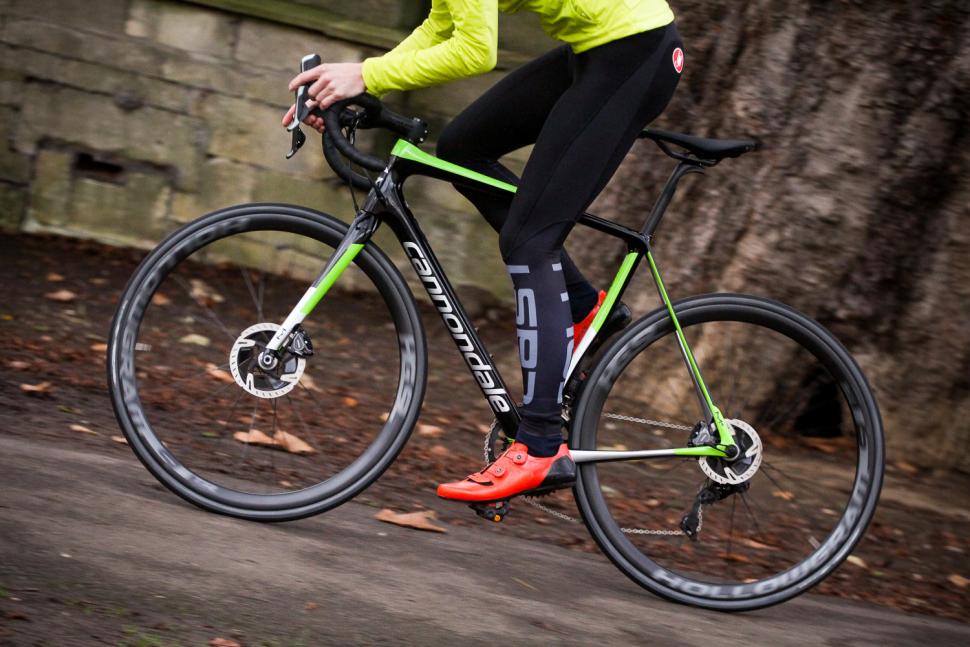
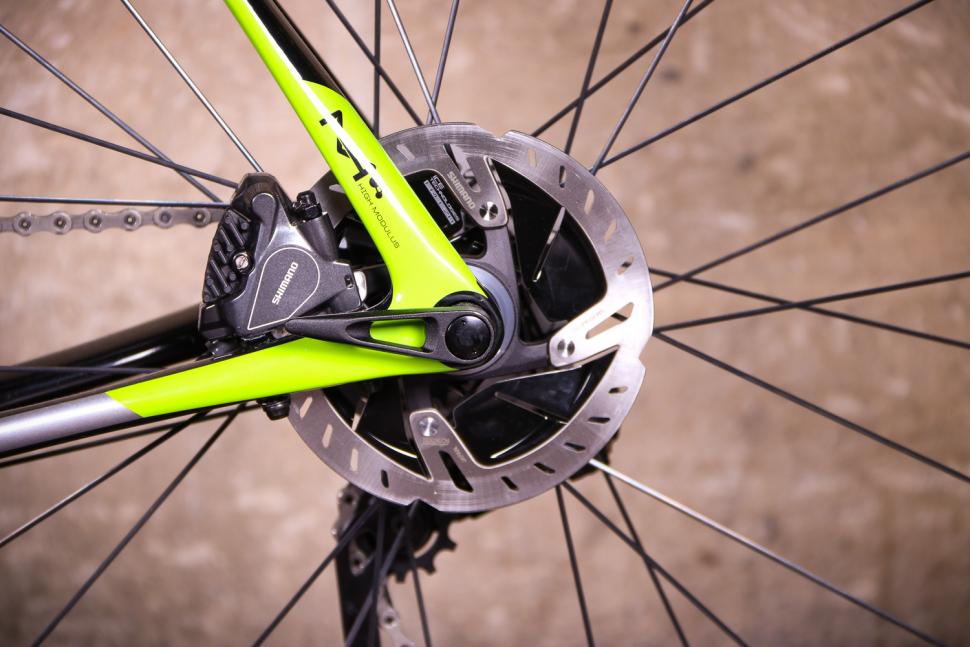

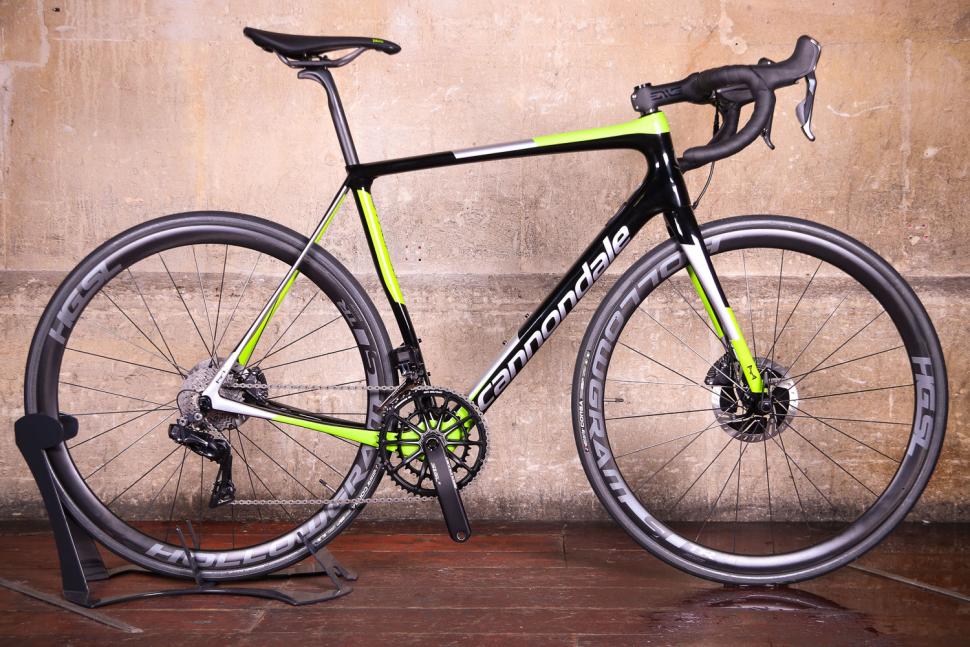





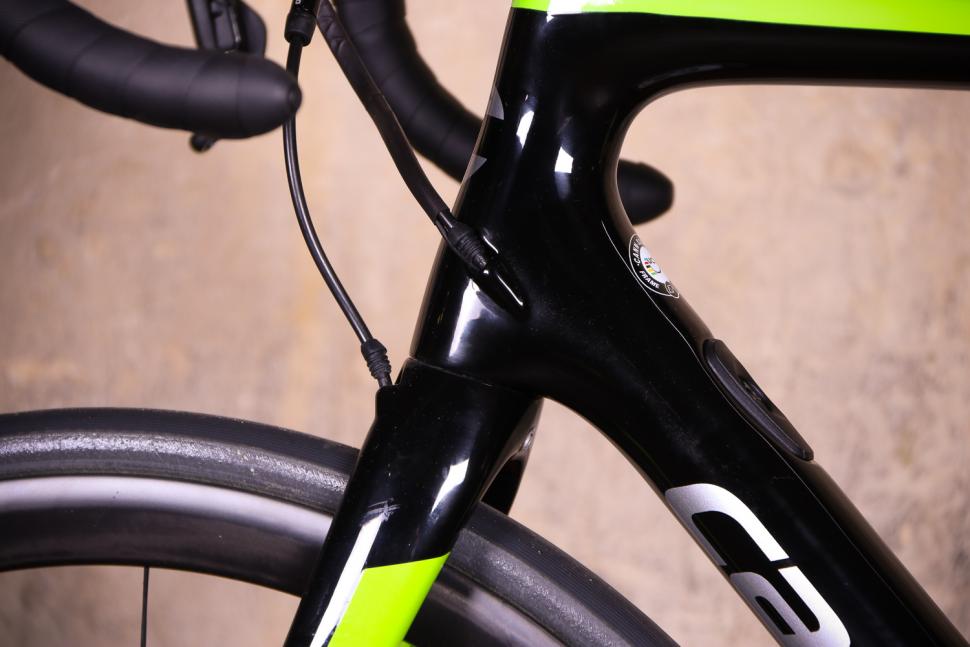
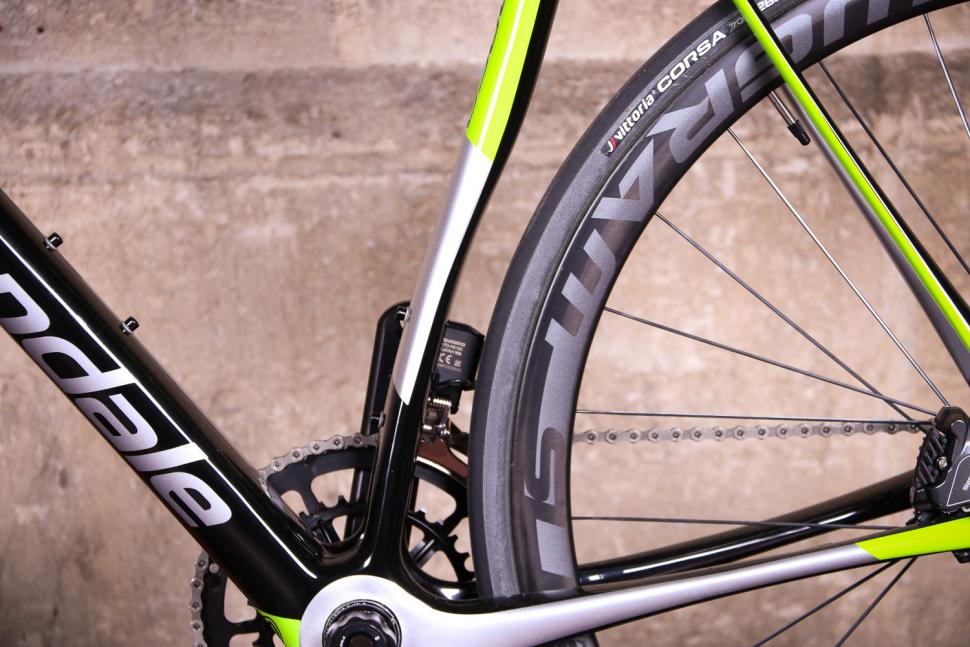


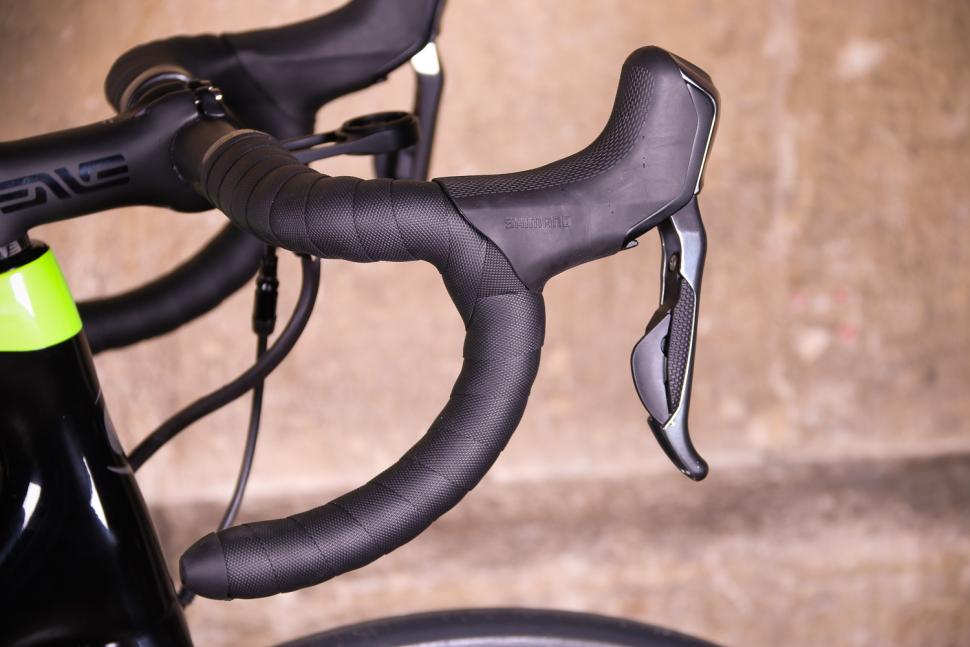
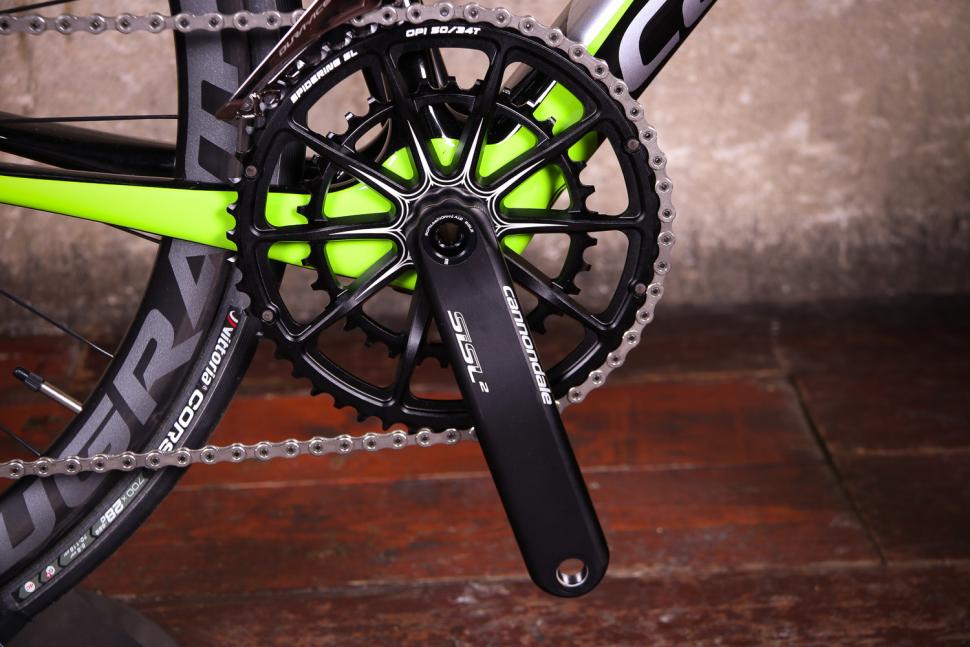
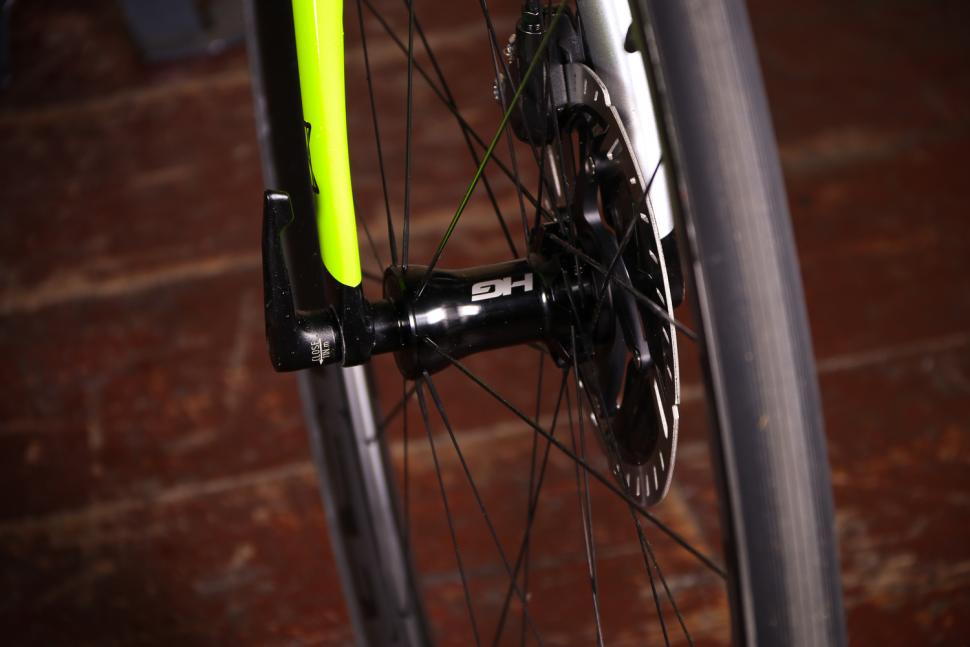
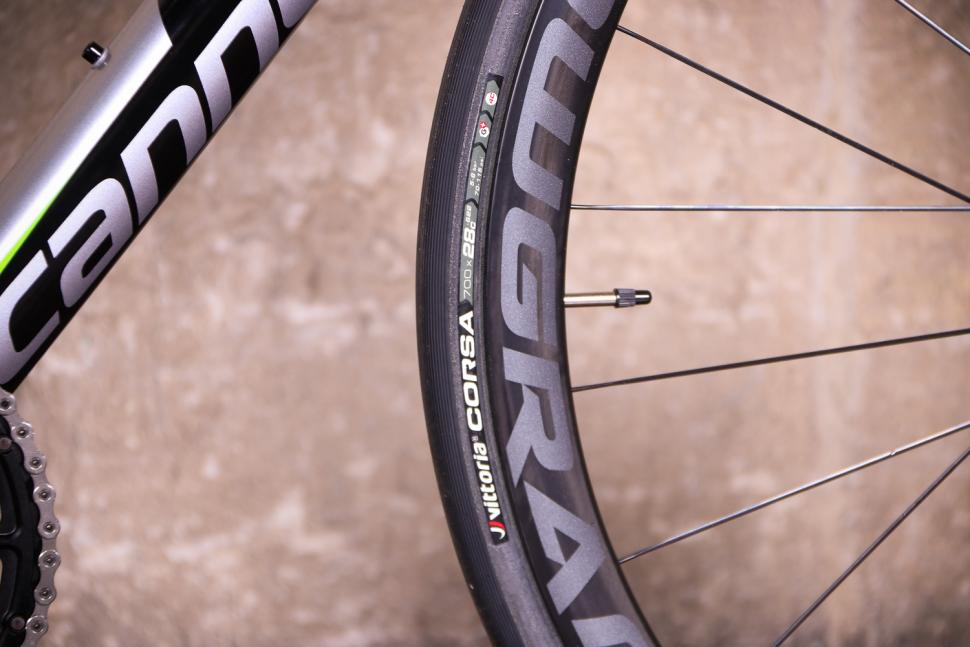
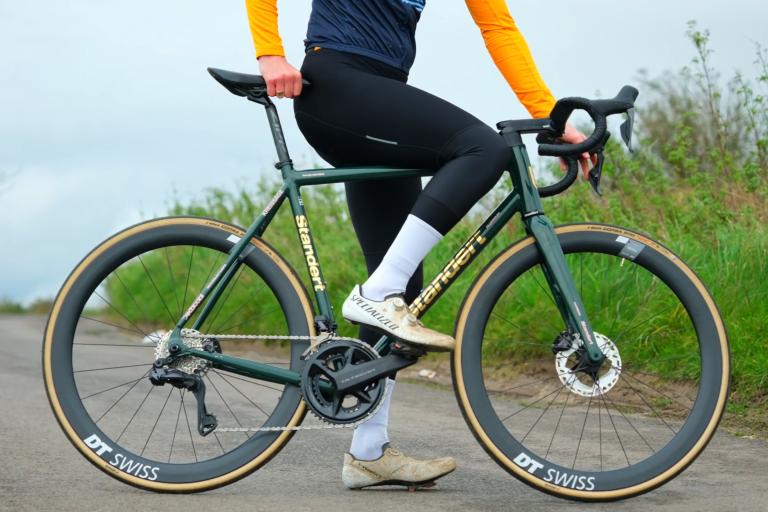
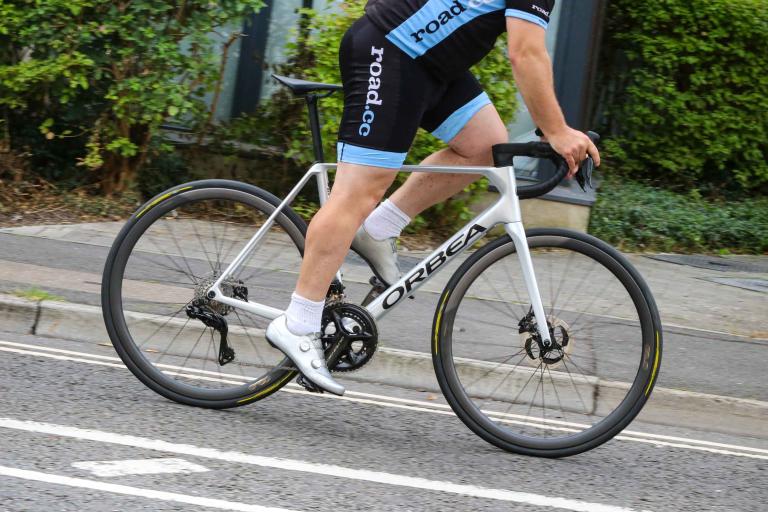
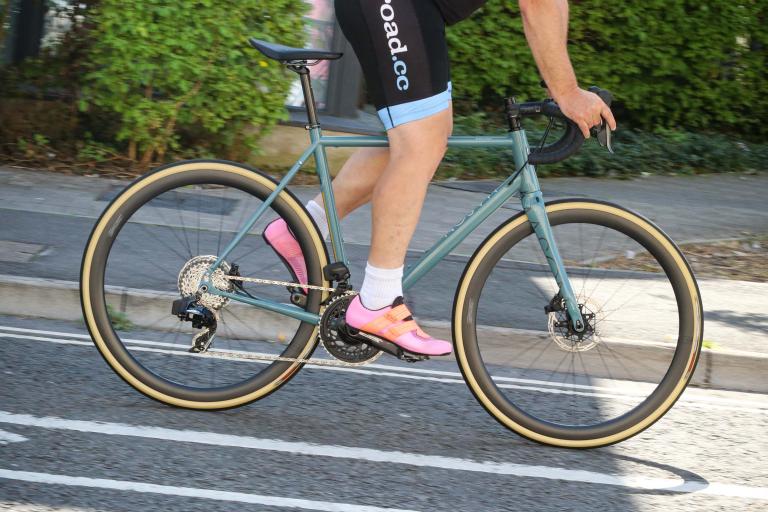
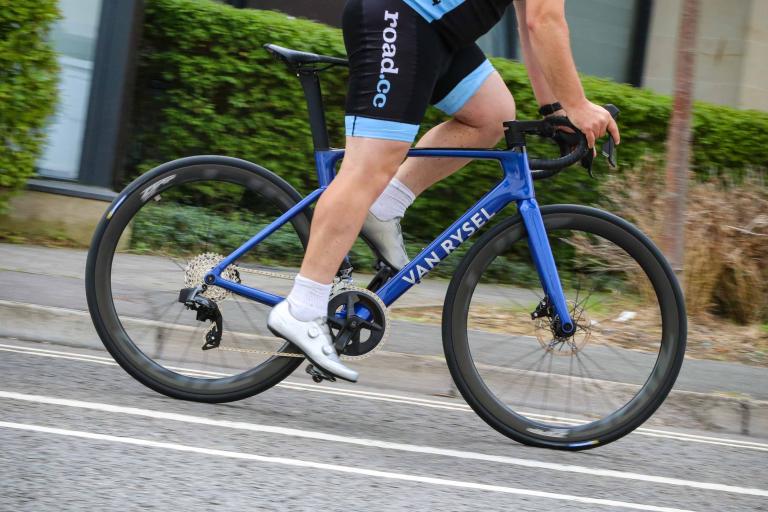
Add new comment
34 comments
I know which build I would go for.
I've not yet had the chance to test either electronic groupset but, after much experience of the mechanical gruppos, once you switch to SRAM you'll not want to go back to Shimano & you'll certainly not want to pay extra to do so!
Good question. I think it comes down to which groupset you prefer really, both have their merits. The new Dura-Ace disc brakes are very impressive, and the compact hoods (not the ones on this test bike) are very nice to use, none of the bulk of other disc brake levers and smaller than eTap HRD.
I think some of the price difference is also down to the Enve bars and stem, the Cannondale Hollowgram SiSL2 crankset (483g when we weighed one a couple of years ago road.cc/96522) and the wheels, SL on this bike and Si on the eTap bike, but I need to speak to Cannondale to see what the difference, other than the name, amounts to.
So there are a few key changes aside from the different groupset between the two bikes worth considering if you're choosing between the two.
A bit out of my price range in this configuration, but it does look nice. I am also a bit oldschool prefering mechanical shifting.
I am currently on the 2016 Synapse Carbon Ultegra Disk upgraded with new wheels and some of the R8000 parts. I do still love it, but I am starting to look around for an upgrade.
But the Synapse range is a bit strange. I am happy with Ultegra, but I would like a Hi-Mod frame. This combination is not available. There are two Ultegra builds, both don't seem to be using the new rotors. Only the SE version comes with the SAVE seatpost and spider chainset.
Also shame about the SAVE handlebar.
My current plan is to wait a bit longer and try to buy the Hi-Mod frameset for a reasonable price and move my current groupset and wheels over from my current bike.
I did exactly that with a 2016 Hi-Mod frame last year (which I picked up in a sale in early 2017 despite it being identical to the 2017 model ). The only odd thing I can say is that my bike (Ultegra Di2 spec, same seat and crank as above) weighs less than the new D-A bike above . Other than the change to flat mount calipers which 'could'(???!?) be heavier I can't figure out why that is given the new frame is meant to be "220g lighter". I have a feeling that is wrong - I don't have any hard evidence but I'm sure when I weighed my 2016 frame it weighed a lot less than 1150g (below 1000g from what I remember)
). The only odd thing I can say is that my bike (Ultegra Di2 spec, same seat and crank as above) weighs less than the new D-A bike above . Other than the change to flat mount calipers which 'could'(???!?) be heavier I can't figure out why that is given the new frame is meant to be "220g lighter". I have a feeling that is wrong - I don't have any hard evidence but I'm sure when I weighed my 2016 frame it weighed a lot less than 1150g (below 1000g from what I remember)
Pages